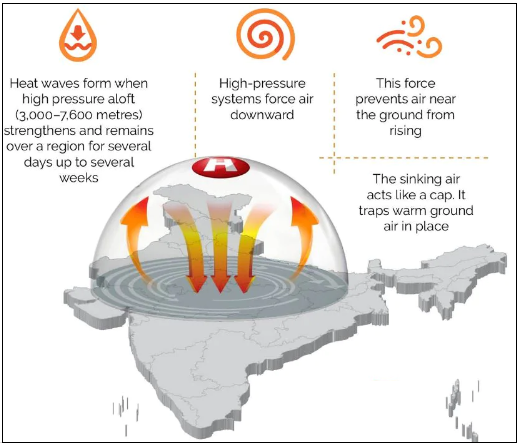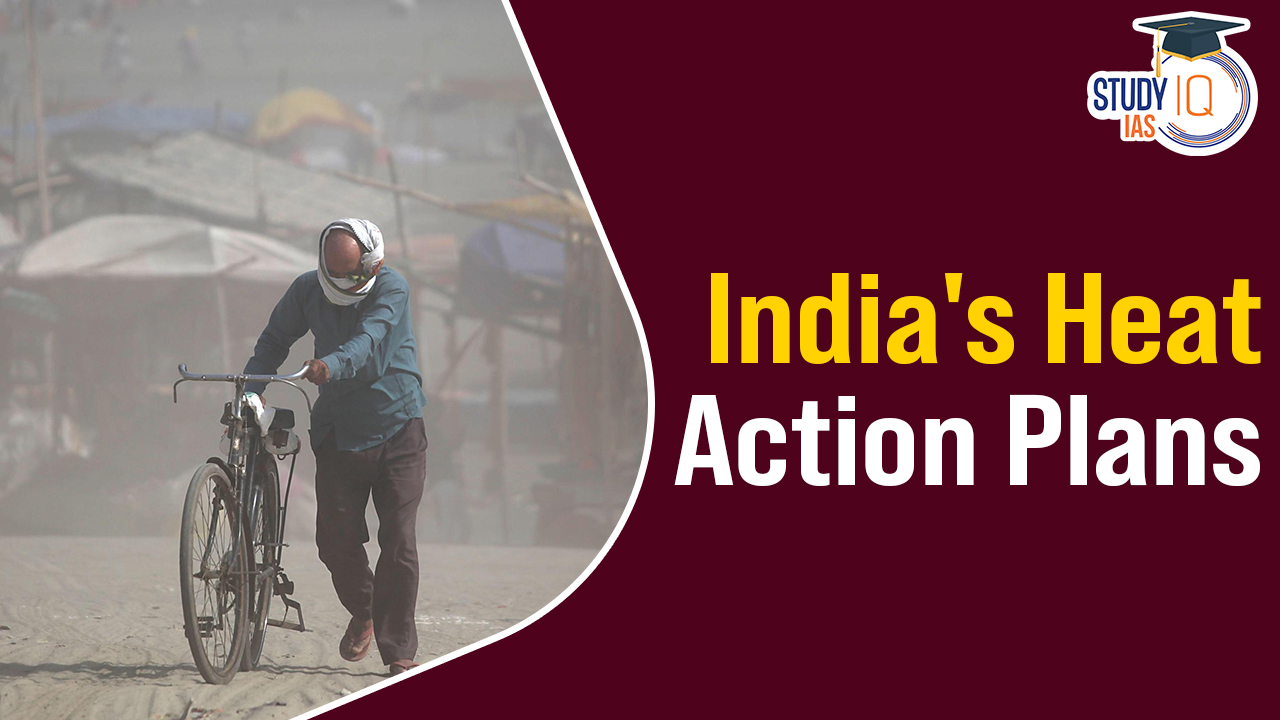Table of Contents
Context: The IMD has predicted an increase in the maximum temperature and the frequency of heatwave conditions in the forthcoming days over eastern and southern India, raising the question of India’s readiness to face this hazard.
Heat Waves: An Overview
- Heat waves are extreme events in which hot temperatures in summer months persist for a relatively long period of time.
- In India, heatwaves typically occur between March and June, and in some rare cases even extend till July.

Criterion for declaring a heatwave in India (as per IMD):
| Heat wave is considered if the maximum temperature of a station reaches at least 40°C or more for Plains and at least 30°C or more for Hilly regions. | |
| Based on Departure from Normal | Based on Actual Maximum Temperature |
| · Heatwave: If departure from normal is 4.5°C to 6.4°C
· Severe heatwave: If departure from normal is >6.4°C |
· Heatwave: When actual maximum temperature ≥ 45°C
· Severe heatwave: When actual maximum temperature ≥47°C |
| Note: If above criteria met at least in 2 stations in a Meteorological sub-division for at least two consecutive days, then the heatwave will be declared on the second day. | |
| Criteria for describing a heatwave in coastal stations: When maximum temperature departure is 4.50C or more from normal, Heat Wave may be described provided the actual maximum temperature is 370C or more. | |
How Are We Tackling Heatwaves?
- Heat Action Plans (HAPs): Governments at various levels have developed HAPs to increase preparedness and mitigate adverse impacts of extreme heat. These plans outline strategies and measures to prepare for, address, and recover from heatwaves.
- Components of HAPs:
-
- Vulnerability Assessment: Identifies regions requiring immediate attention.
-
- Response Plan: Recommends mitigating measures before, during, and after a heatwave.
-
- Role Assignment: Specifies responsibilities of various departments and agencies.
Recommendations of HAPs
- Early Warning Systems: Utilize forecasts to alert the public and authorities about impending heatwaves.
- Public Education: Conduct campaigns to raise awareness about heatwave risks.
- Infrastructure Development: Build heat shelters, cooling centers, and ensure access to clean drinking water.
- Healthcare Preparedness: Equip hospitals with supplies and trained staff to handle heat-related illnesses.
Challenges in Addressing Heatwaves Effectively
- Local Context: Current national thresholds for heatwaves need to be adapted to local conditions considering factors like humidity, urban heat island effect, and community vulnerabilities.
- Inconsistent Methods: Methods for vulnerability assessments vary across HAPs, necessitating a transition to robust climate risk assessments.
- Vulnerable Populations: Targeted interventions for vulnerable groups are essential, considering socio-economic differences and informal employment patterns.
- Resource Allocation: Dedicated budgets and financial mechanisms are required to implement HAPs effectively and ensure protection for vulnerable populations.
- Breaking Down Silos: Integration of HAPs with broader urban resilience and climate adaptation plans can improve effectiveness and resource pooling.
- Long-term Measures: Emphasis on nature-based solutions alongside infrastructure development is crucial for the sustainability of HAPs.
Conclusion
As heatwaves become more frequent and severe, the importance of effective heat action plans cannot be overstated. By addressing the challenges outlined above and implementing targeted measures, India can enhance its readiness to tackle the impacts of extreme heat and protect its population, especially the most vulnerable segments, from heat-related hazards.


 Indus Water Treaty 1960 Suspended by Ind...
Indus Water Treaty 1960 Suspended by Ind...
 5 Years of SVAMITVA Scheme and Its Benef...
5 Years of SVAMITVA Scheme and Its Benef...
 Places in News for UPSC 2025 for Prelims...
Places in News for UPSC 2025 for Prelims...





















